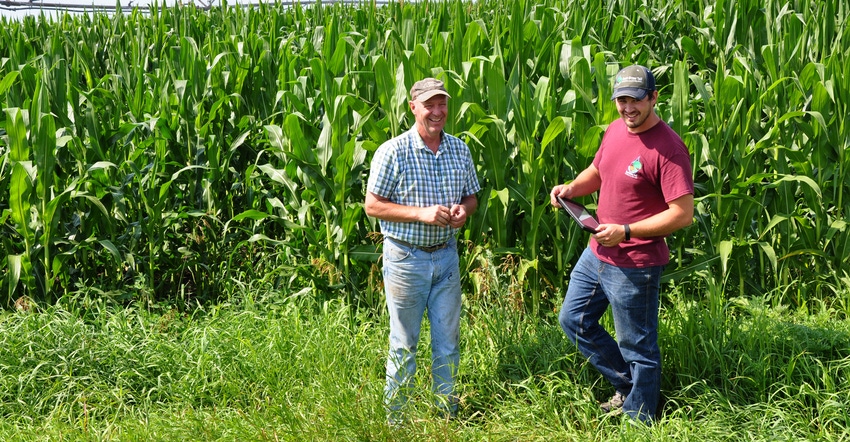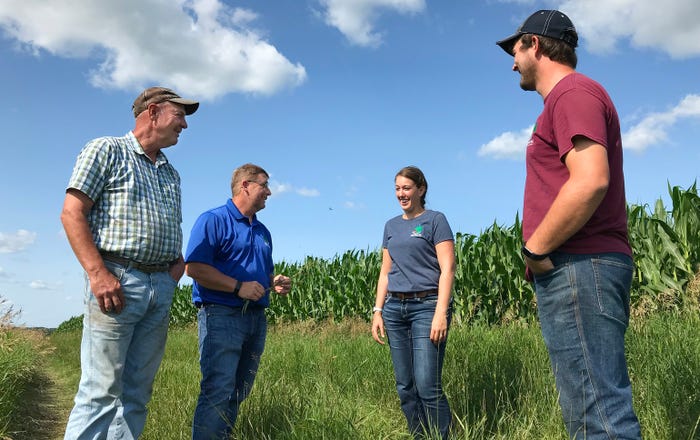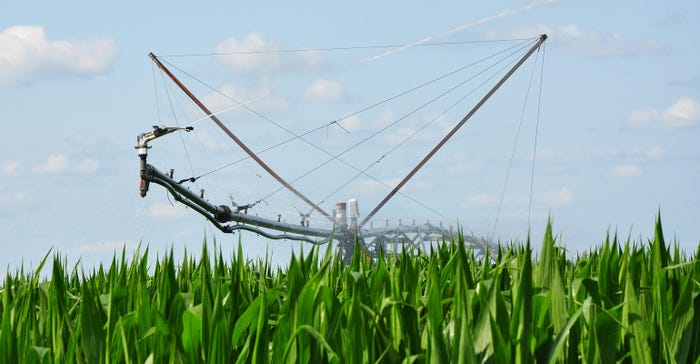July 13, 2020

When Mark Riestenberg, Perham, installed an irrigator in 1995, he looked at a handful of soil and checked to see what the neighbors were doing to decide when to turn it on.
Twenty-five years later, neighbors still rely on neighbors to determine when to irrigate. However, this season they’re watching Riestenberg and 32 other farmers who work with East Otter Tail Soil and Water Conservation District staff on a science-based approach to irrigation scheduling.
“It’s come a lot easier to me now, but it’s certainly nice to have that secondhand verification just to know you’re doing it right,” Riestenberg said during a July 2019 field visit. “Especially being a first-time irrigator, it’s difficult to know when you should be turning that irrigator on.”
About 70 people attended a February 2020 irrigation and nutrient management clinic in New York Mills that highlighted current research in Minnesota, new technologies and how nutrient management works with cover crops.
The annual event is part of ongoing work that, since the early 1990s, has involved assistance from the USDA’s Natural Resources Conservation Service, and Clean Water Funds from the Minnesota Department of Agriculture and the Minnesota Board of Water and Soil Resources.
“It seems like people don’t want to believe research that was done in Nebraska,” said Darren Newville, East Otter Tail SWCD manager. “They want to see this stuff working on our local farms. They want to see it working on Mark’s farm, and then they will copy it. They want to learn from each other.”
 IRRIGATION PLAN: Mark Riestenberg (left) raises crops and hogs in Otter Tail County. He installed an irrigator in 1995 and has been working with the East Otter Tail SWCD and USDA-NRCS on irrigation scheduling. He is shown discussing crop progress in July 2019 with (from Riestenberg’s left) East Otter Tail SWCD manager Darren Newville, SWCD technician Trisha Demarais and irrigation and nutrient management specialist Nathan Wiese.
IRRIGATION PLAN: Mark Riestenberg (left) raises crops and hogs in Otter Tail County. He installed an irrigator in 1995 and has been working with the East Otter Tail SWCD and USDA-NRCS on irrigation scheduling. He is shown discussing crop progress in July 2019 with (from Riestenberg’s left) East Otter Tail SWCD manager Darren Newville, SWCD technician Trisha Demarais and irrigation and nutrient management specialist Nathan Wiese.

Knowing how much and when to irrigate is good for the environment, the crops and the farmers. Newville explained why.
“This area has very coarse-grained soils, which are very productive. But it’s also very droughty. If we don’t get rain, in three or four days the crops will start to suffer,” Newville said. “That same soil characteristic also makes our aquifers very vulnerable to any type of groundwater contamination. If somebody’s [fertilizing] and we get a 2- to 3-inch rain, or if they over-irrigate, they could potentially cause leaching down into our groundwater.”
Water when it’s needed
Irrigation roughly doubled yields on Riestenberg’s 100-acre field.
“Twenty, 30 years ago, it seems irrigation was not necessarily a novelty, but it was something you did to help improve your yield,” Riestenberg said. “Nowadays, if you don’t have it, with the amount of money we’ve got invested in a crop, it’s very difficult to farm without it.”
Minnesota Department of Natural Resources data show 941 of the state’s 6,357 agricultural irrigation permits are for use in Otter Tail County. Thirty percent of all permits in the state come from Otter Tail, Wadena, Todd, Hubbard and Becker counties.
In mid-July 2019, Riestenberg’s corn was starting to produce silks and just about to tassel — the most critical growth stage, when moisture is most important. The crop on this field would produce an average yield of 217 bushels per acre.
Yield drops if insufficient moisture stresses crops. Irrigation scheduling allows farmers to irrigate the right amount at the right time — which uses less water and less electricity.
“If you don’t run it even one turn, you can probably save $1,000 pretty easily,” Riestenberg said of his center pivot irrigator.
“And you can make several thousand dollars by turning it on at the right time,” Newville said.
Reistenberg fertigates, too, applying nitrogen through the irrigator. Instead of twice-a-year applications, he now fertilizes less per application — but more frequently, when the crop needs it most. Ensuring the crop will take up nitrogen saves money and helps protect groundwater.
Perham’s municipal water supply meets state health guidelines, but nitrate levels in some city wells are elevated. The Minnesota Department of Health has linked nitrate to blue baby syndrome.
 RUNOFF REDUCED: Fertigating — applying fertilizer through the irrigator — provides precise application of fertilizer when crops need it and can use it. Smaller, more frequent applications reduce the potential for runoff.
RUNOFF REDUCED: Fertigating — applying fertilizer through the irrigator — provides precise application of fertilizer when crops need it and can use it. Smaller, more frequent applications reduce the potential for runoff.

“Big picture, the nitrate issue is a real important issue for us. By doing the proper irrigation management, they’re not leaching nitrogen into the groundwater due to over-irrigation,” Newville said.
The city worked with East Otter Tail SWCD and others to develop a wellhead protection plan promoting practices that minimize the potential for groundwater contamination.
Luke Stuewe, who supervises the Minnesota Department of Agriculture’s fertilizer management unit in Detroit Lakes, said irrigation scheduling provides tools to protect groundwater.
MDA has provided soil moisture sensing equipment and precipitation monitoring equipment for remote fields. It’s involved in the Central Minnesota Ag Weather Network, an online resource that gathers information from eight weather stations within the five-county area.
“As we looked at the utility of this particular service, we heard loud and clear: Producers are more likely to trust information from equipment on the ground,” Stuewe said.
Local irrigation scheduler program
Farmers enrolled in the irrigation scheduling program receive a chart showing available moisture, crops’ water use and growth stage.
The chart is based on weekly rainfall totals and irrigation amounts that farmers report, plus rain gauge readings and field soil samples that SWCD staff collects. Staff members enter data into an irrigation checkbook. Developed by North Dakota State University and the University of Minnesota Extension, the checkbook accounts for soil moisture and evapotranspiration — and factors in the weather forecast.
“We can’t control the rain, but we can control the irrigation,” Newville said.
Three East Otter Tail SWCD staff members are working this season with farmers in 74 fields throughout Otter Tail, Wadena and Todd counties. In previous years, they had worked with Hubbard County farmers. Becker SWCD started its own program.
Farmers pay the SWCD $200 a year for the service. The SWCD doesn’t make money from the program, Newville noted, adding that board members wanted to support the endeavor.
Irrigation scheduling was a condition of NRCS assistance. In the 1990s, the most common NRCS practice related to irrigation water management was low-pressure nozzle conversion.
Most producers continued irrigation scheduling after the required three years.
Onto cover crops
East Otter Tail SWCD used a $58,000 accelerated implementation Clean Water Fund grant from BWSR to pinpoint what groundwater protection and ag production practices farmers wanted to try next — and what was stopping them. From a series of meetings organized by the Freshwater Society, the SWCD learned producers wanted to try technology such as precision irrigation and practices such as cover crops.
In response to that feedback, 22 farmers from East Otter Tail and Wadena counties have signed up to work on a three-year cover crop demonstration site project. The sites were scheduled to be planted in July, weather permitting. East Otter Tail SWCD was one of five SWCDs to receive a combined $1 million in Clean Water Funds for cover crop demonstration grants this year.
“This program is designed for them to experiment with cover crops and share their experiences with the others in the program,” Newville said. “By sharing their successes along with their failures with each other, they can learn what works in our area as well as what doesn’t work.”
Source: Minnesota Board of Soil and Water Resources, which is solely responsible for the information provided and is wholly owned by the source. Informa Business Media and all of its subsidiaries are not responsible for any of the content contained in this information asset.
You May Also Like




